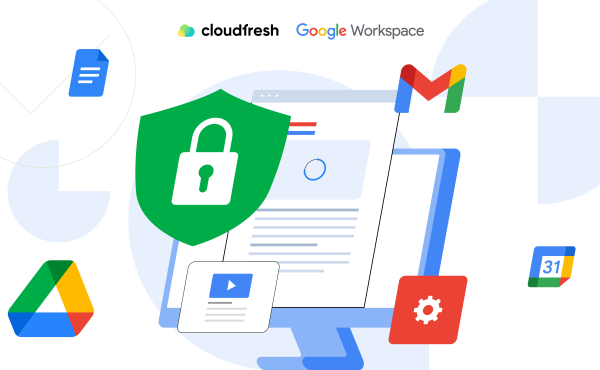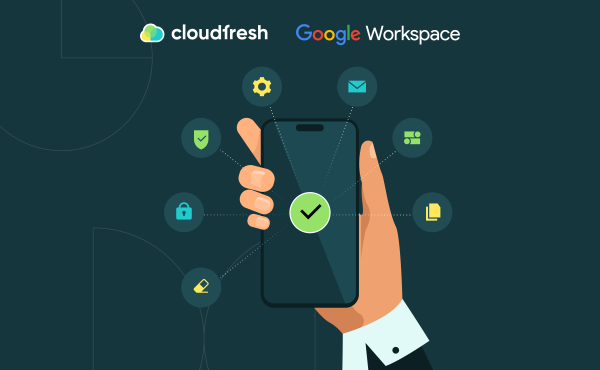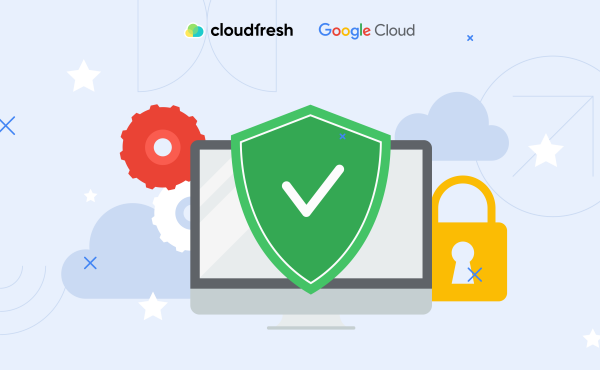Understanding Data Loss Prevention (DLP) in Google Workspace
Types of Phishing Attacks: How to Spot the Bait & Stay off the Hook
- Which 4 Types of Phishing Attacks Are Trending?

- How to Protect against All 4 Types of Phishing

- How to Avoid the Most Common Types of Phishing

- Exit Quiz: Test Your Knowledge of the Hottest Phishing Types
- Protect Your Business Emails against Various Phishing Types with Google Workspace
Phishing isn’t going anywhere. It’s still one of the most effective and costly types of cybercrime out there.
In early 2025, the Anti-Phishing Working Group reported a sharp rise—33%—in Business Email Compromise (BEC) attacks targeting wire transfers. The average request? Nearly US$129,000.
Verizon’s 2025 Data Breach Investigations Report says that people are involved in 60% of security breaches, which largely include various types of phishing attacks. Scammers know exactly where the cracks are. And more often than not, it’s not the tech. It’s us.
The good news is that, being a Google Workspace consulting services provider with a proven track record, we’ll gladly share our knowledge on how to defend against those.
Which 4 Types of Phishing Attacks Are Trending?
Phishing has leveled up. Nowadays, it’s all about precision, speed, and psychological manipulation, all powered by AI.
Attackers today don’t need to guess. They analyze social media posts, company news, and old data leaks to craft emails that sound like they came from your boss or your boss’s boss. They know who you are, what you’re working on, and how you talk.
With AI, they can pump out thousands of unique, realistic messages in seconds.
Type 1. The Era of AI: Hyper-Personalization, Deepfakes, Polymorphic Attacks, and Automation
Email phishing used to be easier to spot. Poor wording, weird links, generic greetings. Not anymore. AI writes better than most people, using perfect grammar and a friendly, human tone.
Remember when a video call was the gold standard of trust? The problem is that the types of phishing attacks using AI-generated deepfakes now mimic real people’s voices, faces, mannerisms, and all. One high-profile case involved a finance worker in Hong Kong who wired US$25.6 million after conferencing with what seemed to be their U.K.-based CFO. The people on the call looked and sounded exactly like colleagues. Well, they weren’t. Every single one was a deepfake.
In its Global Cybersecurity Outlook 2025, the World Economic Forum reported a 223% jump in the sale of deepfake tools on the dark web. That’s not just alarming, but a signal that this tech is becoming cheaper, better, and more widespread.
Today’s assaults don’t look the same twice. AI enables attackers to create slight changes to each message, which helps them dodge security filters that rely on patterns. According to KnowBe4’s 2025 Phishing Threat Trends Report, over 76% of phishing emails have had at least one polymorphic trait recently.
This trend is killing off old-school detection methods like rule-based filters, signature detection, and blocklists.
AI isn’t just making all types of phishing smarter. It’s making them easier. Even low-level attackers with no coding skills can launch massive campaigns with near-zero effort. Off-the-shelf phishing kits are everywhere, and automation is doing most of the work.
The cybersecurity gap is widening. Big companies with AI-powered defenses are holding the line. Smaller ones? Not so much. The WEF warns of growing “cyber inequality,” where those who can’t afford next-gen tools are left exposed.
This isn’t just a tech problem, but a strategy problem. Security budgets need to reflect today’s reality: you’re not just fighting hackers, you’re fighting their machines.
Type 2. Ransomware’s Resurgence: Advanced Payloads and Obfuscation Phishing Techniques
It isn’t just about stealing passwords. It’s the main way ransomware gets in.
Between November 2024 and February 2025, ransomware delivered via phishing jumped 57.5%. Over half of all ransomware attacks started with an email. That’s not a coincidence. It’s a pattern. Ransomware and phishing are two sides of the same coin.
Organizations need to treat email security as their frontline defense against the types of phishing attacks that involve ransomware. Waiting until after the infection is too late.
Type 3. Emerging Attack Vectors: Quishing and Multi-Channel Social Engineering
Quishing, or phishing via QR code, is spreading fast. QR codes in emails, on posters, or mailed letters can now lead to fake sites or malware. In the U.S., for example, tens of millions of people have faced this particular type of phishing, according to CNBC’s July 2025 article.
This hybrid threat blurs digital and physical boundaries. Defense strategies must adapt. It’s not just email anymore, and security awareness needs to extend into the real world.
Attackers are increasingly using Slack, Teams, SMS, voice calls, and social media to reach targets. In some cases, they blend channels and send an email, follow up with a fake call from a cloned executive, and then circle back with a deepfake video.
That’s a big shift, and it means security can’t live in silos. A holistic approach is essential.
Type 4. Supply Chain Vulnerabilities: Exploiting Trusted Third-Party Relationships
Attacks are also creeping in through the supply chain. About 11% of phishing emails in 2024 came from compromised vendors. That’s a big deal because those emails come with built-in trust.
In its 2025 Global Digital Trust Insights, PwC found that third-party breaches are among the most fearsome issues, which include, as we can derive, different types of phishing attacks, for leaders worldwide (35% of respondents). And most importantly, they’re also among those the senior leadership feels least prepared to deal with.
A small vendor with weak defenses can open the door to a much larger compromise.
Organizations need to extend Zero Trust beyond their own walls. That means constant vetting, strict access controls, and real-time monitoring, not just periodic check-ins.
Proactive steps—like those recommended by KPMG—include regularly reviewing your list of software vendors and other key third parties to avoid over-reliance. It also means consistently evaluating their security practices.
The goal is to understand not just your direct partners, but also the “nth-party” dependencies that sit deeper in the supply chain, McKinsey says in its July 2025 piece. With that visibility, you can build solid contingency plans that account for disruptions at any level, not just the obvious ones.
How to Protect against All 4 Types of Phishing
Phishing attacks are getting smarter, but our defenses aren’t lagging behind. The best protection is a mix of innovative tech and solid practices.
Smarter Email Security with AI
AI-based email filters are your first line of defense. They don’t just look for known bad links or suspicious subject lines. They learn from patterns, e.g., who’s sending the email, what it says, and how it compares to normal messages.
Take Gmail, for example. Its AI blocks over 99.9% of spam, phishing, and malware before it ever hits your inbox. Some systems using machine learning and natural language processing can even catch tricky types of phishing scams like fake invoices—stuff older filters might miss.
Use MFA That Can’t Be Broken
Multi-Factor Authentication (MFA) adds a backup layer in case your password gets stolen. But not all MFA is equal. Text messages can be intercepted. That’s why passkeys are getting so much attention.
Passkeys use things like your fingerprint, Face ID, or a secure PIN to verify who you are. Your private key stays locked on your device, so there’s nothing for a hacker to steal. In fact, the EU’s top cybersecurity agency now recommends passkeys as the best-available MFA that’s resistant to nearly all types of phishing attacks.
Trust No One by Default
The old rule was “trust but verify.” Now it’s “never trust, always verify.” That’s the idea behind Zero Trust.
Every request to access your system, whether from inside the office or halfway around the world, is checked and re-checked. It helps stop the intrusion even if someone clicks a bad link. Zero Trust keeps access tightly controlled, based on who the user is, what they need, and what’s normal for them.
Email Authentication Protocols (SPF, DKIM, DMARC)
As you already know, phishing often involves fake emails that look like they’re from someone you communicate with. That’s where email authentication comes in.
Protocols like Sender Policy Framework, DomainKeys Identified Mail, and Domain-based Message Authentication, Reporting & Conformance make it harder for scammers to pretend they’re someone else. They check if a message is really coming from the sender’s domain, hasn’t been tampered with, and doesn’t fall under common types of phishing.
In the U.K., government security experts even tell organizations to enforce DMARC as a basic requirement.
Keep Sensitive Data Where It Belongs
Phishing doesn’t always stop at stealing passwords. Some attacks aim to trick users into leaking sensitive information.
That’s why Data Loss Prevention (DLP) tools should be non-negotiable. They help control how files and messages are shared, especially within tools like Google Drive, Chat, and Gmail. If an account does get compromised, DLP can prevent confidential files from being sent outside the company.
Update Everything—Yes, Everything
Attackers love old software. If there’s a known flaw, they’ll find and use it, even with not-so-fancy types of phishing attacks.
The fix is to keep all your systems, apps, and security tools up to date. Devs often roll out security patches that close the exact holes phishers look for. Would you leave your front door wide open at night? That’s exactly what skipping updates is like.
Email Gateways Still Matter
Even with advanced AI and MFA, traditional solutions like Secure Email Gateways (SEG) and Integrated Cloud Email Security (ICES) still play a key role.
Some newer tools focus on plugging gaps that older gateways and even Microsoft 365 sometimes miss. Gartner still recommends SEG and ICES as part of a layered email security strategy.
Stay ahead with Threat Intelligence
Good defense starts with good data. Real-time threat intelligence can spot attacks early and help respond faster. As a Cloudflare partner, we know that their systems scan over 4.4 trillion data points every day across email, DNS, and the web. Google Security Operations takes that a step further with automated tools that monitor threats, run investigations, and respond instantly as its Threat Intelligence platform sees global trends related to emerging types of phishing in real time.
Don’t Forget the Browser and Devices
Phishing doesn’t always come through email. Sometimes the browser is the weak link.
ZTE-enabled ChromeOS blocks untrusted apps, runs only verified software, and protects core files from tampering. So far, it’s reported zero ransomware cases and no known viruses. Chrome Enterprise Premium includes Enhanced Safe Browse to catch malicious sites while you surf.
Still, a solid antivirus tool on all endpoints helps scan for and stop malware that slips through.
How to Avoid the Most Common Types of Phishing
Even with the best security tools in place, people are often the last line of defense. That’s why building a strong security culture and teaching employees how to spot threats is just as important as any cybersecurity services.
Make Training Count
Security awareness training (SAT) shouldn’t be a one-and-done event. It needs to be consistent, relevant, and engaging.
Start by teaching employees how to spot red flags: strange requests, urgent messages, odd email addresses, or anything that feels off. But remember—AI has changed the game. Today’s phishing emails are more convincing than ever, so training has to go deeper.
That’s where behavior comes in. Top platforms are leading the charge with personalized, adaptive learning. As employees get better, the training gets harder. Add a little gamification (think of points, leaderboards, and recognition), and you’ve got a recipe for engagement that sticks.
And don’t punish people for mistakes, regardless of the types of phishing attacks they haven’t yet developed expertise in. Support them. Fear kills communication. Security is a team effort, and every click, report, or question matters.
Security training is best when it’s regular, realistic, and tied to real behavior, not check-the-box compliance.
Teach People to Pause and Think
Phishing works because it preys on speed and emotion. The faster someone reacts, the more likely they are to fall for it.
That’s why teaching critical thinking is key. Train employees to slow down and verify. If something seems off, don’t click. Don’t download. Don’t reply. Instead, go straight to the official website or contact the company using a known channel, not the one in the email.
Build Good Habits around Signing In
Passwords are still part of the equation, and they need to be strong, unique, and stored in a password manager. No more reusing the same login across sites. And if you haven’t considered the move to passkeys yet, it’s time. They’re safer, easier, and nearly immune to all types of phishing.
Make Reporting Easy
It should be crystal clear how to report something fishy. Quick reports stop an attack in its tracks. So does a company-wide reminder that every report matters.
Outside your organization, you can forward suspicious emails to your country’s cyber authority or use tools like Google’s Report Phishing feature. The more data these systems have, the better they can look for advanced signs of phishing and block future threats.
Use Out-of-Band Verification
As we’ve already mentioned, with deepfake and voice types of phishing scams on the rise, fraud is getting more personal and harder to detect. That’s where out-of-band verification comes in.
Create a simple “safety password” to confirm identities in emergencies or scams involving clone phishing.
What to Do If One Falls for It
If someone does get caught by any of the types of phishing attacks mentioned earlier, time is everything.
Immediately instruct them to:
- Change any exposed passwords.
- Disconnect the affected device from the network.
- Alert the IT and/or security team.
- Notify the bank or financial services if sensitive data was involved.
If personal information or company data was exposed, keep an eye on the dark web for leaked credentials. There are services that can monitor for this.
Backups Are Your Safety Net
When it comes to recovery, backups are your best friend, but only if they’re done right. Backups should be regular, tested, and most importantly, stored separately from your main systems.
Google Drive’s version history can help recover files that have been encrypted recently.
That way, even if ransomware hits, your data is safe and ready to restore.
Test Your Knowledge of the Hottest Phishing Types
Protect Your Business Emails against Various Phishing Types with Google Workspace
When it comes to defending against endless types of phishing scams, Google Workspace offers more than just the basics. It brings powerful tools built right into the platform:
- Gmail neutralizes nearly all spam, phishing, and malware automatically. It scans emails before they land in your inbox, checking attachments, short links, and embedded images. Messages from lookalike domains or unauthenticated senders are flagged clearly, helping users spot impersonation attempts fast.
- Safe Browse protects users across the web and apps, not just in Gmail. It detects risky sites and links in real time through Chrome Enterprise.
- Google Workspace follows a Zero Trust model: every login is verified based on user identity, device, and context. Access controls are granular, and the principle of least privilege is enforced.
- It supports secure MFA options like passkeys and security keys, especially for high-risk users. Frequent cookie rotation helps prevent session hijacking. Admins can limit superuser roles and enroll key staff in the Advanced Protection Program.
- DLP policies protect sensitive data in Gmail, Google Chat, and Drive. Admins can restrict external sharing, default new files to private, and enforce policies by team or department.
- Admins can review and revoke access for unused or risky third-party apps connected via OAuth, reducing exposure to hidden threats.
- All data is encrypted, both at rest and in transit. TLS and client-side encryption ensure strong protection, even with third-party services or across borders.
- The Security Investigation Tool helps admins act quickly on cyber threats. Logs can be exported to Google Security Operations or BigQuery for deeper analysis and custom reporting.
- Google Workspace balances strong security with ease of use. It meets global compliance standards like ISO/IEC 27001, ISO/IEC 27017, ISO/IEC 27701, SOC 2, SOC 3, FedRAMP, BSI C5, and MTCS to protect both users and data without gett-ing in the way.
Cloudfresh is a global Google Cloud Premier Partner specialized in Work Transformation. If you’re ready to start successfully fending off those numerous types of phishing attacks on your business, feel free to reach out using the short form below!















